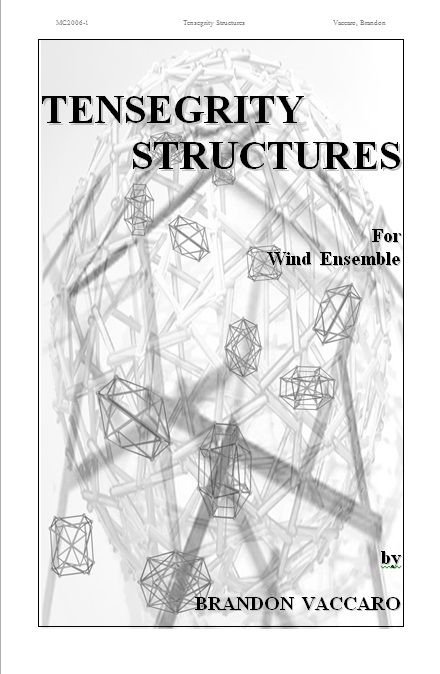
Tensegrity Structures
for Wind Ensemble
Audio
Score
1. Creation Myths p. 1
A way a lone a last a loved a long the rivverrun, past Eve and Adam’s
James Joyce
2. Golden Age p. 13
To make the world work in the shortest possible time through spontaneous cooperation without ecological offense or the disadvantage of anyone.
Buckminster Fuller
3. Decay p. 21
Disneyland exists in order to hide that it is the “real” country, all of the “real” America that is Disneyland.
Jean Baudrillard
Notes from the composer
Tensegrity Structures was composed in Spring 2003. The original work was scored for an eclectic chamber group consisting of clarinet, horn, accordion, percussion, violin, and cello. It was commissioned by The Playground ensemble (formerly The Experimental Playground Ensemble or TEPE) as part of the Visual Sounding Series at the Museum of Contemporary Art/Denver. It was featured in an exposition titled Elegy: Contemporary Ruins, a multi-artist photographic exposition dealing with the decline of American culture as manifest in abandoned industrial sites, dead business districts, and other architectural ruins.
This wind ensemble version was completed in the winter of 2006.
The commission was for a piece that would relate to the subjects of the exposition: the decline of culture and architecture. My views on culture have been influenced by Alfred Korzybski’s ideas on humans as “time-binders,” and by R. Buckminster Fuller’s application of these ideas. Bucky (as he preferred to be called) observed a westward, and occasionally northward, progression of wealth and capital throughout human history. As each empire came to its end, the next empire lay to the west, from the Sumerians to Babylon, Assyria to Egypt, Greece to Rome, London to New England (old American wealth) to Texas (oil wealth) to California and Japan (silicon wealth). Cultures seem to end, but the knowledge, wealth, and capitol, the “bound-up time” of that culture is inherited by the next.
While I was writing this piece, I was doing research on Colin McPhee, a Canadian composer who moved to Bali during the 1930s and wrote extensively on gamelan music. After returning to North America, he composed a number of pieces using gamelan motives. Due to the amount of time I spent on this research, the sound of Bali was in my ear.
I was unsure how my piece would relate to architecture. While music involves structure and form, the tools of the architect, I wanted a more concrete reference. After a few weeks of research and brainstorming, I came across Bucky’s definition of architecture as “the art of making big structures from small structures.” I was reminded of gamelan, and the way gamelan pieces are built from small motivic elements.
Since Bucky came up twice in my pre-composing research, it seemed appropriate to pay homage to him by titling the piece after one of his most important innovations.
The word “tensegrity” is an invention: a contraction of “tensional integrity.” Tensegrity describes a structural-relationship principle in which structural shape is guaranteed by the finitely closed, comprehensively continuous, tensional behaviors of the system and not by the discontinuous and exclusively local compressional member behaviors. Tensegrity provides the ability to yield increasingly without ultimately breaking or coming asunder
R. Buckminster Fuller
Tensegrity Structures rely mostly on tension for their structural integrity. This proves far more efficient than conventional structures that rely mostly on compression. These structures occur in nature and can be utilized by humans in engineering. The Geodesic dome, the 60-carbon organic molecule Buckminsterfullerene (the “Bucky ball”), DNA (the double-helix), woven column structures, and woven space-frames are all tensegrity structures.
The Music
The piece is in three sections: Creation Myths, The Golden Age, and Decay. A theme ties the three sections, and its transformation is the real “story” of the piece. This programmatic aspect represents the rise, peak, and decline of a culture. By utilizing a single theme throughout the work, I tried to represent the ongoing process of time-binding that underlies the rise and fall of cultures.
The theme is based on a pelog, a type of Balinese pentatonic scale usually built from minor 2nds and major 3rds. After the initial statement of the theme, the piece progresses from a tense, dissonant harmonic language to a more consonant section using the pelog. This becomes “contaminated” with more pitch classes, eventually utilizing an octatonic scale for the final section of the piece. The structure of this pelog lent itself well to this sort of transformation, and the pan-tonal nature of the octatonic scale was easy to relate to the Balinese sound of the pelog. This builds to a climactic Cataclysm, followed by a resolution as the “pure” form of the theme finally reasserts itself. The piece ends much as it began and seems to end with more questions than answers, hinting at the rise of the next culture.
The piece is a showcase for the first percussionist, who plays vibraphone through the entire piece. The theme first appears, and most of the major transformations are signaled, in this part.
Comments are closed